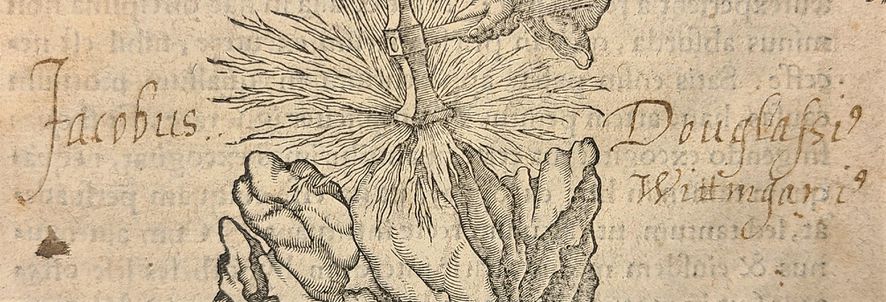Difference between revisions of "James Douglas d.1635"
(Created page with "__NOTITLE__ ===name::James name::DOUGLAS d.date of death::1635=== ====Biographical Note==== Son of family::William Douglas, Laird of Whittingehame (d.1596) i...") |
|||
| (One intermediate revision by the same user not shown) | |||
| Line 16: | Line 16: | ||
His books are identifiable by the inscription “Jacobus Douglassius Wittingamus" generally written on the title page. | His books are identifiable by the inscription “Jacobus Douglassius Wittingamus" generally written on the title page. | ||
[[file:JamesDouglas.jpg|thumb|886px|Inscription James Douglas of Whittingehame (Edinburgh University Library Dd.3.44)]] | [[file:JamesDouglas.jpg|thumb|886px|Inscription James Douglas of Whittingehame (Edinburgh University Library Dd.3.44)]] | ||
| + | |||
====Sources==== | ====Sources==== | ||
<div id="sourcelist"> | <div id="sourcelist"> | ||
Latest revision as of 05:23, 23 May 2023
James DOUGLAS d.1635
Biographical Note
Son of William Douglas, Laird of Whittingehame (d.1596) in East Lothian and Elizabeth Maitland, daughter of Sir Richard Maitland, Lord Lethington. According to W.R Thomas, James Douglas matriculated at the University of Glasgow in 1594, where he met Archibald Napier, son of John Napier, and formed a friendship. In the late 1590s James went to London, where Thomas states he was “almost immediately appointed the King’s private secretary.” However S.T Bindoff, and indeed the Calendar of State papers, state that in 1598 James entered the service of Sir James Elphinstone, the newly appointed Scottish secretary, and in 1601 James is described by his brother Thomas as writer to the secretary of Scotland. (Bindoff, p.19). He may have later become secretary to James VI, as an unidentified MS of his books refers to him as such (discussed below).
According to Thomas, in 1603 James Douglas and Archibald Napier accompanied King James VI/I to London as Gentlemen of the Bedchamber, who was also attended by John Craig as his physician. In London, both Craig and Douglas were “keenly interested in the outburst of book-buying activity at Court,” and both had access to the Old Royal Library (Thomas, p.201).
Books
On his death in 1635, James Douglas of Whittingehame gave 85 mathematical and astronomy books to Edinburgh University library. Among them were a number of books previously owned by John Craig ca.1550-?1620, physician to King James VI, which included Tycho Brahe’s presentation copy of his work on the comet of 1577 to Craig (Dd.5.50). Further research is still required to understand the full extent of Douglas’ donations, as his provenance has not been incorporated into the online catalogue of Edinburgh University Library, though his books are identifiable by his inscription.
W.R Thomas’ 1935 article is the only scholarship which discusses Douglas’ library in any detail. He states that there is a contemporary catalogue entitled Catalogus librorum mathematicorum quos Jacobus Douglassius Wittingamius Jacobi Regi Sexto secretaries Academiae Jacobi Regis testament legavi listing the books given by Douglas to the university. The document is allegedly endorsed “Catalogue of the books delivered be Harie Young to King James his College at Edinburgh Decemb. 1635.” Further research is required to identify precisely which MS this is.
Characteristic Markings
His books are identifiable by the inscription “Jacobus Douglassius Wittingamus" generally written on the title page.
Sources
- Bindoff, S, T. ‘A bogus envoy from James I’ History, NEW SERIES Vol. 27, No. 105 (1942): 15-37
- Hall, John T D. ‘The History and Development of Special Collections in Edinburgh University Library’ The Bibliotheck; a Scottish Journal of Bibliography and Allied Topics Vol. 10, Iss. 5, (1981)
- Salisbury, E. (ed.) Calendar of the Cecil Papers in Hatfield House: Volume 14, Addenda (accessed online, originally published by His Majesty's Stationery Office, London, 1923) (esp. p.85)
- Thomas, W. R. ‘John Napier.’ The Mathematical Gazette 19, no. 234 (1935): 192–205
